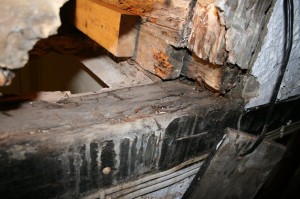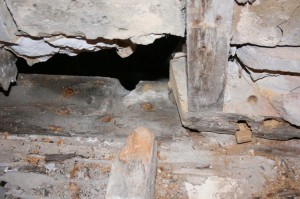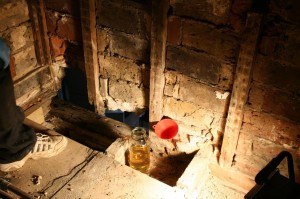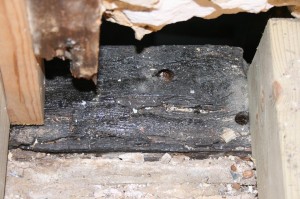The house with the partly rotted timber frame is of course mine. It’s the reason that I am associated with Smiths Clear Penetrating Epoxy Sealer (CPES)™ in the first place. I have been a user of it over many years now. Old houses, lots of wood, a bit of research, eventually you end up using CPES.
The Rotten Timber Frame, and the House Itself
The house was built around 1880, and is of a mock Tudor construction. In 1880 that meant a timber frame which is in softwood in my case. The house has had many additions, most worse built than the original part. Furthermore it has suffered from some neglect in the past. In particular it has a very rotten timber frame at the back under a leaky bathroom.
This particular beam measures 7″ by 5″ and spans the back wall of my house. Replacement of it would have posed something of a serious issue. It functions as a lintel over some door and window frames. In the rotten area, over 2 feet long, it just supports joists and the wall that sits atop it. This wall is of stud and brick on end construction. It is a bathroom that is an addition to the house and where the leaks came from.
NOTE: Click on any picture to see it full size, then use the back button to return to the article.
The Rotten Timber Frame and The Causes of the Rot
The timber on the bottom of the hole is the primary affected timber. It looks OK from the outside, but closer inspection revealed the truth. The sawn off cast iron waste pipe was connected (or rather wasn’t connected) to the bath inside, through pipes that ran through the hole.
A close look at the timber reveals extensive decay. The top face is soft enough that a screwdriver can be pushed through with negligible pressure. A finger can be pushed through in the worst areas.
A leaking bath drain had caused the damage over at least 15 years. Additionally a leaking window above had been adding to the destruction.
The view from the inside confirms the picture. There is one joist completely missing from this photo, and the joist on the right has lost the end of itself to rot. The foot for the Studs has completely rotted in the affected area and the base of the studs are also affected. The Lath and cement ceiling now sports some serious ventilation for the toilet below, and affords rather less privacy than it should…
The next structural timber, running towards the front of the house, has also been affected by rot. This is insufficient to cause worry, we must just just stop the rot from recurring.
The Repair Must Carry Joists and a Bath, and the Rot Must Be Stopped
There is a solid wall below the rotten timber, so my aim here is to consolidate the timber to the point where it will carry the joists, with a LARGE bath on them, without being crushed.
This photo shows the same corner of the finished bathroom. That bath is 1800 * 800mm, so will contain approximately a quarter of a tonne of water (250kg) when filled.
Smiths CPES will easily achieve this degree of consolidation. Furthermore it will protect the wood from rot in the future. The timber is now inside the house and the new bath is properly plumbed so it should stay dry. This should mean rot is no longer an issue.
Smiths CPES will penetrate deeply into all of the rotten timber frame, the stuff that we can see, and the stuff that is less rotten that we can’t, by running along the fibres of the wood, and through all rotten areas. It will leave those fibres coated in, and consolidated by, the Epoxy resin in CPES, which will add the strength to the wood to carry the joists, and prevent further rot.
Repairing the Rotten Timber Frame With Smiths Clear Penetrating Epoxy Sealer™ (CPES)
We drill holes through the timber initially to aid penetration of the CPES into the timber.
These holes can be fairly large, and should penetrate deeply into the timber, but NOT pass through the timber. We want the CPES to saturate the rotten wood, not pour down the wall below!
Many holes are drilled in all affected timbers.
Mix CPES, LOTS of CPES. Rotten timbers can easily consume their volume of CPES.
Easy mixing by marking a straight jar with marks at 8 and 16cm, and filling to the first with Part A, the second with Part B.
Please wear rubber gloves always, all epoxy products can cause sensitisation, rubber gloves is the sure..
A funnel pushed into the drilled hole makes it even easier to add the CPES.
Keep pouring till it stops absorbing.
Work around the holes till the wood is saturated, and will absorb no more. Use multiple funnels if you have them.
Once the solvents have evaporated, which takes from a few hours to a few days if the timbers are as large as these, you then repeat the process. This will firm the timber up even more as more resin consolidates the wood further. Carry on until the rotten timber frame does not absorb further significant CPES.
The Finished Product, Toughened Timber, Resistant to Rot and Water, Capable of Carrying Joists.
The rotten timber frame took about one week to evaporate its solvents after each saturation with CPES. Once the final saturation with CPES had been performed and the resin had hardened the joists were reinstated / repaired as appropriate.
The joist on the left is held upright with the small brace to the stud, as it just rests on a brick wall at its other end. The repaired rotten timber frame carries all of the load of the joist, which has the large bath on it.
The close up shows the consolidated timber, which has been thoroughly saturated with CPES. In total I used around 5 or 6 litres of CPES to affect this repair, a lot, and not cheap, but far cheaper than replacing that timber with a wall and joists on top of it!
What If The Rotten Timber Frame Was More Structural, a Lintel for a Door Perhaps?
There are many possibilities for structural repair using Smiths CPES, but it is of course very hard to offer blanket assessments and generic ‘How To’ guides. Please contact us for more information or if you have any doubt about the suitability for a specific repair.
So What Is Smiths CPES™?
Steve Smith, an American Scientist, invented Clear Penetrating Epoxy Sealer in the 70’s. It is utterly unique as a product. It is proven for more than 40 years in the marine and house restoration markets. This product is now available to the European market through MakeWoodGood. It’s capabilities and performance are well documented on the internet, including at www.woodrestoration.com/.
Please phone us with any problems you may have, and we will be only too happy to assist.
-
£48.50 – £415.00 Select options This product has multiple variants. The options may be chosen on the product page













